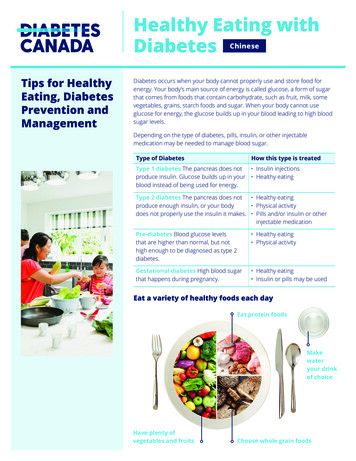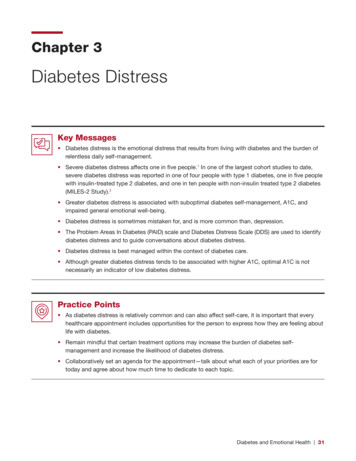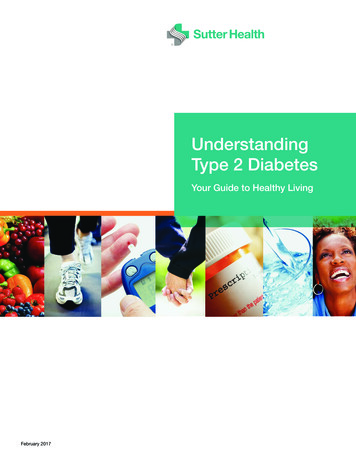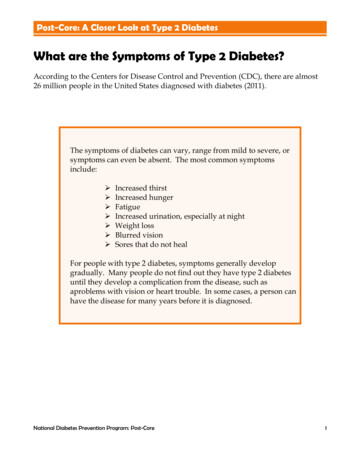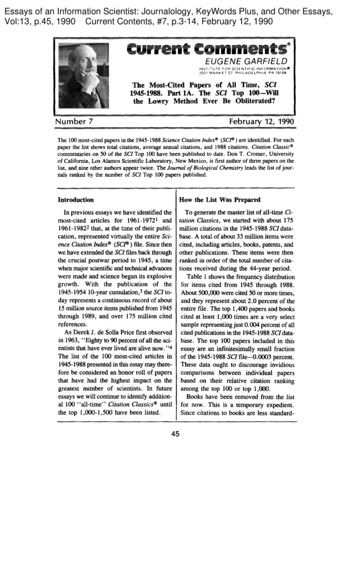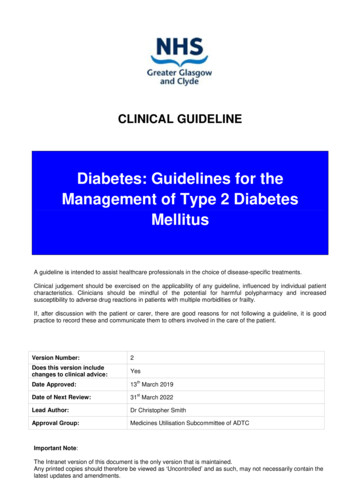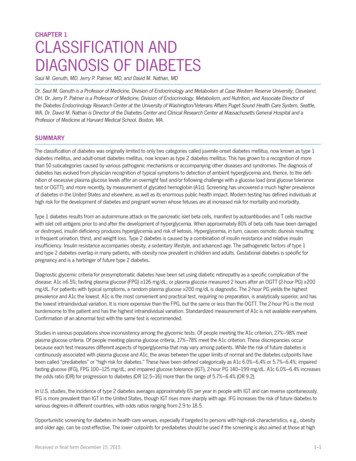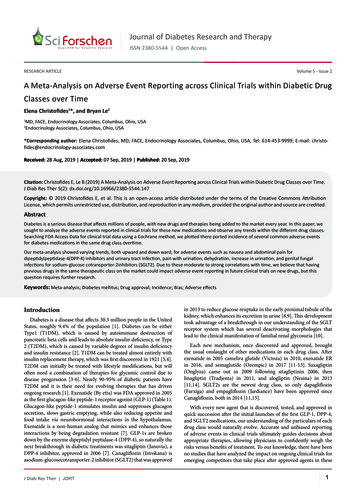
Transcription
Sci ForschenOpen HUB for Scientific Researc hJournal of Diabetes Research and TherapyISSN 2380-5544 Open AccessVolume 5 - Issue 2RESEARCH ARTICLEA Meta-Analysis on Adverse Event Reporting across Clinical Trials within Diabetic DrugClasses over TimeElena Christofides1*, and Bryan Le2MD, FACE, Endocrinology Associates, Columbus, Ohio, USAEndocrinology Associates, Columbus, Ohio, USA12*Corresponding author: Elena Christofides, MD, FACE, Endocrinology Associates, Columbus, Ohio, USA, Tel: 614-453-9999; E-mail: christofides@endocrinology-associates.comReceived: 28 Aug, 2019 Accepted: 07 Sep, 2019 Published: 20 Sep, 2019Citation: Christofides E, Le B (2019) A Meta-Analysis on Adverse Event Reporting across Clinical Trials within Diabetic Drug Classes over Time.J Diab Res Ther 5(2): dx.doi.org/10.16966/2380-5544.147Copyright: 2019 Christofides E, et al. This is an open-access article distributed under the terms of the Creative Commons AttributionLicense, which permits unrestricted use, distribution, and reproduction in any medium, provided the original author and source are credited.AbstractDiabetes is a serious disease that affects millions of people, with new drugs and therapies being added to the market every year. In this paper, wesought to analyze the adverse events reported in clinical trials for these new medications and observe any trends within the different drug classes.Searching FDA Access Data for clinical trial data using a Cochrane method, we plotted there ported incidence of several common adverse eventsfor diabetes medications in the same drug class overtime.Our meta-analysis showed varying trends, both upward and down ward, for adverse events such as nausea and abdominal pain fordipeptidylpeptidase-4(DPP-4) inhibitors and urinary tract infection, pain with urination, dehydration, increase in urination, and genital fungalinfections for sodium-glucose cotransporter-2inhibitors (SGLT2). Due to these moderate to strong correlations with time, we believe that havingprevious drugs in the same therapeutic class on the market could impact adverse event reporting in future clinical trials on new drugs, but thisquestion requires further research.Keywords: Meta-analysis; Diabetes mellitus; Drug approval; Incidence; Bias; Adverse effectsIntroductionDiabetes is a disease that affects 30.3 million people in the UnitedStates, roughly 9.4% of the population [1]. Diabetes can be eitherType1 (T1DM), which is caused by autoimmune destruction ofpancreatic beta cells and leads to absolute insulin deficiency, or Type2 (T2DM), which is caused by variable degrees of insulin deficiencyand insulin resistance [2]. T1DM can be treated almost entirely withinsulin replacement therapy, which was first discovered in 1921 [3,4].T2DM can initially be treated with lifestyle modifications, but willoften need a combination of therapies for glycemic control due todisease progression [3-6]. Nearly 90-95% of diabetic patients haveT2DM and it is their need for evolving therapies that has drivenongoing research [1]. Exenatide (By etta) was FDA approved in 2005as the first glucagon-like peptide-1 receptor agonist (GLP-1) (Table 1).Glucagon-like peptide-1 stimulates insulin and suppresses glucagonsecretion, slows gastric emptying, while also reducing appetite andfood intake via neurohormonal interactions in the hypothalamus.Exenatide is a non-human analog that mimics and enhances thoseinteractions by being degradation resistant [7]. GLP-1s are brokendown by the enzyme dipeptidyl peptidase-4 (DPP-4), so naturally thenext breakthrough in diabetic treatments was sitagliptin (Januvia), aDPP-4 inhibitor, approved in 2006 [7]. Canagliflozin (Invokana) isasodium-glucosecotransporter-2 inhibitor (SGLT2) that was approvedJ Diab Res Ther JDRTin 2013 to reduce glucose reuptake in the early proximal tubule of thekidney, which enhances its excretion in urine [8,9]. This developmenttook advantage of a breakthrough in our understanding of the SGLTreceptor system which has several deactivating morphologies thatlead to the clinical manifestation of familial renal glycosuria [10].Each new mechanism, once discovered and approved, broughtthe usual onslaught of other medications in each drug class. Afterexenatide in 2005 camelira glutide (Victoza) in 2010, exenatide ERin 2016, and semaglutide (Ozempic) in 2017 [11-13]. Saxagliptin(Onglyza) came out in 2009 following sitagliptinin 2006, thenlinagliptin (Tradjenta) in 2011, and alogliptin (Nesina) in 2013[11,14]. SGLT2s are the newest drug class, so only dapagliflozin(Farxiga) and empagliflozin (Jardiance) have been approved sinceCanagliflozin, both in 2014 [11,15].With every new agent that is discovered, tested, and approved inquick succession after the initial launches of the first GLP-1, DPP-4,and SGLT2 medications, our understanding of the particulars of eachdrug class would naturally evolve. Accurate and unbiased reportingof adverse events in clinical trials ultimately guides decisions aboutappropriate therapies, allowing physicians to confidently weigh therisks versus benefits of treatment. To our knowledge, there have beenno studies that have analyzed the impact on ongoing clinical trials foremerging competitors that take place after approved agents in these1
Sci ForschenJournal of Diabetes Research and TherapyOpen Access JournalOpen HUB for Scientific Researc hdrug classes were brought to market. In this meta-analysis, we seek toanalyze the impact of sequential clinical trials for GLP-1, DPP-4, andSGLT2 medications on adverse event reporting (Tables 2,3).MethodsThis study was conducted and reported according to the PreferredReporting Items for Systematic Reviews and Meta-Analysis (PRISMA)statement [16]. We searched FDA Access Data for drug approval trialsthrough January 1, 2018 using a Cochrane method. Our eligibilitycriteria required that the study be a mono-therapy, randomizedcontrol trial that had duration of 6 weeks or longer, using adultdiabetic patients and a medication undergoing FDA approval at thetime of the trial. Ultimately, 14 clinical trials were included: sevenGLP-1trials, four DPP-4 trials, and three SGLT2 trials. These trialswere chosen because they were FDA registration trials for each of themedications. These trials were less likely to have contaminated dataregarding adverse events, due to a more controlled environment andexclusion of patients with previous exposure to the studied drug classto avoid suspected non-responders.The most commonly associated reported adverse events for eachdrug class were charted sequentially by FDA approval date and thecoefficient of determination (R2) was plotted for each adverse eventwithin each drug class 95.ResultsAmong the seven included GLP-1s, we identified nausea(R2 0.0882), vomiting (R2 0.0075), abdominal pain (R2 0.018), anddiarrhea (R2 0.273) as the most commonly reported AEs [17]. Noneof these showed a correlation with time of approval.For the four included DPP-4s, we identified nausea (R2 0.9826),vomiting (R2 0.0667), abdominal pain (R2 0.9132), and diarrhea(R2 0.0076) [18-21]. Here, nausea and abdominal pain both showeddownward trends that were strongly correlated with time of approval(Figure 1).Lastly, for SGLT2s, we identified Urinary Tract Infection (UTI)(R2 0.6486), pain with urination (R2 0.75), increase in urination(R2 0.8953), dehydration (R2 0.75), and genital fungal infection(R2 0.843) [9,15,22]. We do see a weak correlation with time ofapproval for UTI, with stronger correlations for pain with urinationand dehydration, and even stronger correlations for genital fungalinfections and increase in urination. However, UTI, pain withurination, and dehydration showed an upward trend while increasein urination and genital fungal infections both showed a downwardtrend.Discussion and ConclusionIn our meta-analysis, we observed that a number of adverse eventsdid show weak to strong correlations with time (DPP-4-nausea andabdominal pain; SGLT2- UTI, pain with urination, dehydration,increase in urination, and genital fungal infections) (Figures 2,3).However, many did not. All adverse events analyzed are welldescribed as side effects of each of their respective drug classes as awhole [9,15,17-22]. Why there is such a discrepancy as time wenton? One possibility is that our growing understanding of the drugclasses caused bias to be introduced to how these adverse events werereported. As greater knowledge about these side effects spread, bothinvestigators and patients could have been affected. Investigatorsmight counsel patients about new potential side effects as they becomeTable 1: GLP-1 Agonist Adverse Events.GLP-1 AgonistsExenatide (Byetta; 2005)Liraglutide (Victoza; 2010)Exenatide (Bydureon; 2012)Albiglutide (Tanzeum; 2014)Dulaglutide (Trulicity; 2014)Lixisenatide (Adlyxn; 2016)Semaglutide (Ozempic; 2017)Correlation coefficient (R2)NauseaVomitingAbdominal .273Table 2: DPP-4 Inhibitor Adverse Events.DPP-4 InhibitorsSitagliptin (Januvia; 2006)Saxagliptin (Onglyza; 2009)Linagliptin (Tradjenta; 2011)Alogliptin (Nesina; 2013)Correlation coefficient (R2)NauseaVomitingAbdominal 0.91322.93.72.13.60.0076Table 3: SGLT2 Inhibitor Adverse Events.SGLT2 InhibitorsCanagliflozin (Invokana; 2013)Dapagliflozin (Farxiga; 2014)Empagliflozin (Jardiance; 2014)Correlation coefficient (R2)UTIPain with UrinationIncrease in UrinationDehydrationGenital Fungal 000.30.752.91.2410.843Citation: Christofides E, Le B (2019) A Meta-Analysis on Adverse Event Reporting across Clinical Trials within Diabetic Drug Classes overTime. J Diab Res Ther 5(2): dx.doi.org/10.16966/2380-5544.1472
Sci ForschenJournal of Diabetes Research and TherapyOpen Access JournalOpen HUB for Scientific Researc h37Abdominal PainNausea2418.719.622422.82.61.816.811.100Exena de Liraglu de Exena de Albiglu de Dulaglu de Lixisena de Semaglu de(Bye a;(Victoza; (Bydureon; (Tanzeum; (Trulicity;(Adlyxn; (Ozempic;2005)2010)2012)2014)2014)2016)2017)Exena de Liraglu de Exena de Albiglu de Dulaglu de Lixisena de Semaglu de(Bye a;(Victoza; (Bydureon; (Tanzeum; (Trulicity;(Adlyxn; (Ozempic;2005)2010)2012)2014)2014)2016)2017)Vomi ngDiarrhea12.613.1910.46.876.44.21110.79.8942Exena de Liraglu de Exena de Albiglu de Dulaglu de Lixisena de Semaglu de(Bye a;(Victoza; (Bydureon; (Tanzeum; (Trulicity;(Adlyxn; (Ozempic;2005)2010)2012)2014)2014)2016)2017)Exena de Liraglu de Exena de Albiglu de Dulaglu de Lixisena de Semaglu de(Bye a;(Victoza; (Bydureon; (Tanzeum; (Trulicity;(Adlyxn; (Ozempic;2005)2010)2012)2014)2014)2016)2017)Figure 1: GLP-1 agonist adverse events for nausea, vomiting, abdominal pain, and diarrhea graphed sequentially.Nausea2.9Abdominal Pain1.32.31.20.71.100Sitaglip n (Januvia;Saxaglip n2006)(Onglyza; 2009)Linaglip nAloglip n (Nesina;(Tradjenta; 2011)2013)Sitaglip n (Januvia;Saxaglip n2006)(Onglyza; 2009)Vomi ngLinaglip nAloglip n (Nesina;(Tradjenta; 2011)2013)Diarrhea3.72.23.62.92.10Sitaglip n (Januvia;Saxaglip n2006)(Onglyza; 2009)00Linaglip nAloglip n (Nesina;(Tradjenta; 2011)2013)Sitaglip n (Januvia;Saxaglip n2006)(Onglyza; 2009)Linaglip nAloglip n (Nesina;(Tradjenta; 2011)2013)Figure 2: DPP-4 inhibitor adverse events for nausea, vomiting, abdominal pain, and diarrhea graphed sequentially.Citation: Christofides E, Le B (2019) A Meta-Analysis on Adverse Event Reporting across Clinical Trials within Diabetic Drug Classes overTime. J Diab Res Ther 5(2): dx.doi.org/10.16966/2380-5544.1473
Sci ForschenJournal of Diabetes Research and TherapyOpen Access JournalOpen HUB for Scientific Researc hUrinary Tract Infec on4.7Dehydra on7.14.37Canagliflozin (Invokana;2013)Dapagliflozin (Farxiga;2014)Empagliflozin (Jardiance;2014)Pain with Urina on2.400Canagliflozin (Invokana;2013)Dapagliflozin (Farxiga;2014)2.900Canagliflozin (Invokana;2013)Dapagliflozin (Farxiga;2014)Empagliflozin (Jardiance;2014)Empagliflozin (Jardiance;2014)Genital Fungal Infec on1.243.70.3Canagliflozin (Invokana;2013)Dapagliflozin (Farxiga;2014)1Empagliflozin (Jardiance;2014)Increase in Urina on1.631.1Canagliflozin (Invokana;2013)Dapagliflozin (Farxiga;2014)Empagliflozin (Jardiance;2014)Figure 3: SGLT2 inhibitor adverse events for urinary tract infection, pain with urination, increase in urination, dehydration and genital fungalinfection graphed sequentially.aware of them, such as abdominal pain. With this information,patients might begin to attribute abdominal pain from all sourceswith the study medication and there could be an increase in what theyreport. Alternatively, patients who are aware that a study medicationcould make them nauseous might take steps to avoid the side effect,by pre-medicating or taking it with food, and thus report it less often.Investigators too might ask patients more questions surroundinga certain side effect if they expect it, eliciting more incidents thanpatients may have independently reported. Without access to specificprotocols for patient counseling for each drug trial and measures totrack what specific information patients received or did not receivebefore taking the study drug, this remains mostly speculation. Thisdoes beg the question though about study design and how to properlyconduct informed consent in the setting of ongoing clinical trials withnovel agents already on the market.This study does have several weaknesses. We only looked at threedifferent medication classes for a single disease state. Diabetes isa logical choice due to its large economic impact in the US and therecent explosion in novel therapeutic classes [1]. However; it limitsour knowledge of whether the results observed here would apply toother drug classes or disease states. We also only used a single trialfor each drug, in order to analyze data with as little concomitant druginteractions as possible. Single data points for each adverse eventfor each drug makes for less robust statistical analysis. In the trialswe chose, canagliflozin and dapagliflozin did not report on two ofthe adverse events that were analyzed. Because they did not reporton it, it is unclear if they did not receive any reports with a true 0%incidence or if the investigators were not asking and did not look forit. Lacking information about standard operating procedures withineach trial regarding patient counseling and investigator inquiries toCitation: Christofides E, Le B (2019) A Meta-Analysis on Adverse Event Reporting across Clinical Trials within Diabetic Drug Classes overTime. J Diab Res Ther 5(2): dx.doi.org/10.16966/2380-5544.1474
Sci ForschenJournal of Diabetes Research and TherapyOpen Access JournalOpen HUB for Scientific Researc hpatients about adverse events is also a limitation to the data analysis.Thus we recommend a randomized trial where patients are specificallygiven different counseling and information about the same study drugand observe any true differences in how they choose to report adverseevents.Ensuring that adverse events are reported equally and in an unbiasedmanner in clinical drug trials will ensure that clinicians and patientscan make more rational, informed decisions about therapeutic choices.FundingThere were no grants or fellowships supporting the writing of thispaper.References1.Center for Disease Control and Prevention (2017) National DiabetesStatistics Report 2017.2.American Diabetes Association (2018) 2. Classification and Diagnosisof Diabetes: Standards of Medical Care in Diabetes-2018. DiabetesCare 41: S13-S27.3.American Diabetes Association (2018) 8. Pharmacologic Approachesto Glycemic Treatment: Standards of Medical Care in Diabetes-2018.Diabetes Care 41: S73-S85.9.Riser Taylor S, Harris KB (2013) The Clinical Efficacy and Safety ofSodium Glucose Cotransporter-2 Inhibitors in Adults with Type 2Diabetes Mellitus. Pharmacotherapy 33: 984-999.10. Santer R, Calado J (2010) Familial Renal Glucosuria and SGLT2: froma Mendelian Trait to a Therapeutic Target. Clin J Am Soc Nephrol 5:133-141.11. White JR Jr (2014) A Brief History of the Development of DiabetesMedications. Diabetes Spectr 27: 82-86.12. Trujillo JM, Nuffer W, Ellis SL (2015) GLP-1 receptor agonists: areview of head-to-head clinical studies. Ther Adv Endocrinol Metab6: 19-28.13. Tran KL, Park YI, Pandya S, Muliyil NJ, Jensen BD, et al. (2017)Overview of Glucagon-Like Peptide-1 Receptor Agonists for theTreatment of Patients with Type 2 Diabetes. Am Health DrugBenefits 10: 178-188.14. Karagiannis T, Boura P, Tsapas A (2014) Safety of dipeptidyl peptidase4 inhibitors; a perspective review. Ther Adv Drug Saf 5: 138-146.15. Nauck MA (2014) Update on developments with SGLT2 197inhibitors in the management of type 2 diabetes. Drug Des DevelTher 8: 1335-1380.16. Moher D, Liberati A, Tetzlaff J, Altman DG, PRISMA Group (2010)Preferred Reporting Items for Systematic Reviews and MetaAnalyses: The PRISMA Statement. Int J Surg 8: 336-341.4.Diabetes Milestones Timeline. American Diabetes Association.5.American Diabetes Association (2018) 3. Comprehensive MedicalEvaluation and Assessment of Comorbidities: Standards of MedicalCarein Diabetes-2018. Diabetes Care 41: S28-S37.6.American Diabetes Association (2018) 4. Lifestyle Management:Standards of Medical Care in Diabetes-2018. Diabetes Care 41:S38-S50.7.Drucker DJ, Nauck MA (2006) The incretin system: glucagon-likepeptide-1 receptor agonists and dipeptidyl peptidase-4 inhibitors intype 2 diabetes. Lancet 368: 1696-1705.20. JANUVIA (sitagliptin) Tablets Initial US Approval 2006.Wilding J, Fernando K, Milne N, Evans M, Ali A, et al. (2018) SGLT2Inhibitors in Type 2 Diabetes Management: Key Evidence andImplications for Clinical Practice. Diabetes Ther 9: 1757-1773.22. Drug Safety Communications: FDA revises labels of SGLT2 inhibitorsfor diabetes to include warnings about too much acid in the bloodand serious urinary tract infections (2018) US Food & Drug.8.17. Prasad-Reddy L, Isaacs D (2015) A clinical review of GLP-1 receptoragonists: efficacy and safety in diabetes and beyond. Drugs Context4: 212283.18. DPP-4 Inhibitors (2016) Diabetes Daily.19. DPP-4 Inhibitors (Gliptins) Diabetes.co.uk.21. ONGLYZA (saxagliptin) Tablets Initial U.S. Approval: 2009.Citation: Christofides E, Le B (2019) A Meta-Analysis on Adverse Event Reporting across Clinical Trials within Diabetic Drug Classes overTime. J Diab Res Ther 5(2): dx.doi.org/10.16966/2380-5544.1475
*Corresponding author: Elena Christofides, MD, FACE, Endocrinology Associates, Columbus, Ohio, USA, Tel: 614-453-9999; E-mail: christo-fides@endocrinology-associates.com Citation: Christofides E, Le B (2019) A Meta-Analysis on Adverse Event Reporting across Clinical Trials within Diabetic Drug Classes over Time.

